Green Approaches on Modification of Xylan Hemicellulose to Enhance the Functional Properties for Food Packaging Materials—A Review
Abstract
1. Introduction
2. Modification of Xylan Hemicelluloses by Esterification
2.1. Xylan Hemicellulose–Potential Applications and Industrial Availability
2.2. Acetylation of Xylan Hemicelluloses with Long-Chain Anhydrides
2.3. Acetylation of Xylan Hemicelluloses with Acetic Anhydride

2.4. Acetylation of Xylan Hemicelluloses with Ionic Liquids (ILs)
3. Enzymatic Modification of Hemicelluloses
4. Conclusions
Author Contributions
Funding
Institutional Review Board Statement
Data Availability Statement
Acknowledgments
Conflicts of Interest
References
- Khwaldia, K.; Arab-Tehrany, E.; Desobry, S. Biopolymer coatings on paper packaging materials. Compr. Rev. Food Sci. Food Saf. 2010, 9, 82–91. [Google Scholar] [CrossRef]
- Türe, H.; Gällstedt, M.; Johansson, E.; Hedenqvist, M.S. Wheat-gluten/montmorillonite clay multilayer-coated paperboards with high barrier properties. Ind. Crop. Prod. 2013, 5, 11–16. [Google Scholar] [CrossRef]
- Guillard, V.; Gaucel, S.; Fornaciari, C.; Angellier-Coussy, H.; Buche, P.; Gontard, N. The Next Generation of Sustainable Food Packaging to Preserve Our Environment in a Circular Economy Context. Front. Nutr. 2018, 5, 121. [Google Scholar] [CrossRef]
- Liu, K.; Liang, H.; Nasrallah, J.; Chen, L.; Huang, L.; Ni, Y. Preparation of the CNC/Ag/beeswax composites for enhancing antibacterial and water resistance properties of paper. Carbohydr. Polym. 2016, 142, 183–188. [Google Scholar] [CrossRef]
- Johansson, C.; Bras, J.; Mondragon, I.; Nechita, P.; Plackett, D.; Simon, P.; Svetec, D.G.; Virtanen, S.; Baschetti, M.G.; Breen, C.; et al. Renewable fibers and bio-based materials for packaging applications—A review of recent developments. BioResources 2012, 7, 2506–2552. [Google Scholar] [CrossRef]
- Tondi, G.; Schnabel, T. Bio-Based Polymers for Engineered Green Materials. Polymers 2020, 12, 775. [Google Scholar] [CrossRef]
- Lopez, O.V.; Castillo, L.A.; Garcia, M.A.; Villar, M.A.; Barbosa, S.E. Food packaging bags based on thermoplastic corn starch reinforced with talc nanoparticles. Food Hydrocoll. 2015, 43, 18–24. [Google Scholar] [CrossRef]
- Mikkonen, K.S.; Laine, C.; Kontro, I.; Talja, R.A.; Serimaa, R.; Tenkanen, M. Combination of internal and external plasticization of hydroxypropylated birch xylan tailors the properties of sustainable barrier films. Eur. Polym. J. 2015, 66, 307–318. [Google Scholar] [CrossRef]
- Nechita, P.; Roman, M. Review on polysaccharides used in coatings for food packaging papers. Coatings 2020, 10, 566. [Google Scholar] [CrossRef]
- Nesic, A.; Cabrera-Barjas, G.; Dimitrijevic-Brankovic, S.; Davidovic, S.; Radovanovic, N.; Delattre, C. Prospect of Polysaccharide- Based Materials as Advanced Food Packaging. Molecules 2020, 25, 135. [Google Scholar] [CrossRef]
- Zhao, Y.; Li, B.; Li, C.; Xu, Y.; Luo, Y.; Liang, D.; Huang, C. Comprehensive Review of Polysaccharide-Based Materials in Edible Packaging: A Sustainable Approach. Foods 2021, 10, 1845. [Google Scholar] [CrossRef]
- Ramosa, A.; Sousaa, S.; Evtuguinb, D.; Gamelasd, J. Functionalized xylans in the production of xylan-coated paper laminates. React. Funct. Polym. 2017, 117, 89–96. [Google Scholar] [CrossRef]
- Akubude, V.C.; Okafor, J.A.; Oyedokun, O.O.; Petinrin, K.N. Application of Hemicellulose in Biohydrogen Production. In Sustainable Bioconversion of Waste to Value Added Products; Inamuddin, A.K., Ed.; Springer: Cham, Switzerland, 2021; p. 254. [Google Scholar]
- Christopher, L. Adding Value Prior to Pulping: Bioproducts from Hemicellulose. In Global Perspectives on Sustainable Forest Management; Clement, A., Ed.; Okia Muni University: Arua, Uganda, 2012; pp. 225–246. [Google Scholar]
- Gao, Y.; Guo, M.; Wang, D.; Zhao, D.; Wang, M. Advances in extraction, purification, structural characteristics and biological activities of hemicelluloses: A review. Int. J. Biol. Macromol. 2023, 225, 467–483. [Google Scholar] [CrossRef]
- Liu, G.S.; Shi, K.; Sun, H. Research Progress in Hemicellulose-Based Nanocomposite Film as Food Packaging. Polymers 2023, 15, 979. [Google Scholar] [CrossRef]
- Zhang, X.Q.; Luo, W.H.; Xiao, N.Y.; Chen, M.J.; Liu, C.F. Construction of functional composite films originating from hemicellulose reinforced with poly(vinyl alcohol) and nano-ZnO. Cellulose 2020, 27, 1341–1355. [Google Scholar] [CrossRef]
- Ebringerová, A.; Heinze, T. Xylan and xylan derivatives—Biopolymers with valuable properties, 1. Naturally occurring xylans structures, isolation procedures and properties. Macromol. Rapid Commun. 2000, 21, 542–556. [Google Scholar] [CrossRef]
- Gírio, F.M.; Fonseca, C.; Carvalheiro, F.; Duarte, L.C.; Marques, S.; Bogel-Lukasik, R. Hemicelluloses for fuel ethanol: A review. Bioresour. Technol. 2010, 101, 4775–4800. [Google Scholar] [CrossRef]
- Mikkonen, K.S.; Tenkanen, M. Sustainable food-packaging materials based on future biorefinery products: Xylans and mannans. Trends Food Sci. Technol. 2012, 28, 90. [Google Scholar] [CrossRef]
- Cheng, H.N.; Biswas, A.; Sanghoon, K.; Carlucio, R.; Furtado, A.R. Synthesis and Characterization of Hydrophobically Modified Xylans. Polymers 2021, 13, 291. [Google Scholar] [CrossRef]
- Wang, J.; Minami, E.; Kawamoto, H. Thermal reactivity of hemicellulose and cellulose in cedar and beech wood cell walls. J. Wood Sci. 2020, 66, 41. [Google Scholar] [CrossRef]
- Nechita, P.; Roman, M.; Ciolacu, F. Xylan Hemicellulose: A Renewable Material with Potential Properties for Food Packaging Applications. Sustainability 2021, 13, 13504. [Google Scholar] [CrossRef]
- Bello, F.; Chimpango, A. Tailor-Made Conversion of Mango Seed Husks to Obtain Hemicellulose Suitable for the Production of Thermally Stable Films. Waste Biomass Valorization 2022, 13, 719–737. [Google Scholar] [CrossRef]
- Yang, Y.C.; Mei, X.W.; Hu, Y.J.; Su, L.Y.; Bian, J.; Li, M.F.; Peng, F.; Sun, R.C. Fabrication of antimicrobial composite films based on xylan frompulping process for food packaging. Int. J. Biol. Macromol. 2019, 134, 122–130. [Google Scholar] [CrossRef]
- Xu, G.; Luo, Y.; Song, T.; He, B.; Chang, M.; Ren, J. Preparation and application of a xylan-based antibacterial papermaking additive to protect against Escherichia coli bacteria. BioResources 2020, 15, 4781–4801. [Google Scholar] [CrossRef]
- Fu, G.-Q.; Zhang, S.-C.; Chen, G.-G.; Hao, X.; Bian, J.; Peng, F. Xylan-based hydrogels for potential skin care application. Int. J. Biol. Macromol. 2020, 158, 244–250. [Google Scholar] [CrossRef]
- Lobo, F.C.M.; Franco, A.R.; Fernandes, E.M.; Reis, R.L. An Overview of the Antimicrobial Properties of Lignocellulosic Materials. Molecules 2021, 26, 1749. [Google Scholar] [CrossRef]
- Ma, M.; Ji, X. Extraction, Purification, and Applications of Hemicellulose. Pap. Biomater. 2021, 6, 47–60. [Google Scholar]
- Jung, B.; Shim, M.-K.; Park, M.-J.; Jang, E.H.; Yoon, H.Y.; Kim, H.; Kim, J.-H. Hydrophobically modified polysaccharide-based on polysialic acid nanoparticles as carriers for anticancer drugs. Int. J. Pharm. 2017, 520, 111–118. [Google Scholar] [CrossRef]
- Na, K.; Lee, T.B.; Park, K.-H.; Shin, E.-K.; Lee, Y.-B.; Choi, H.-K. Self-assembled nanoparticles of hydrophobically-modified polysaccharide bearing vitamin H as a targeted anti-cancer drug delivery system. Eur. J. Pharm. Sci. 2003, 18, 165–173. [Google Scholar] [CrossRef]
- Tanaka, R.; Meadows, J.; Williams, P.A.; Phillips, G.O. Interaction of hydrophobically modified hydroxyethyl cellulose with various added surfactants. Macromolecules 1992, 25, 1304–1310. [Google Scholar] [CrossRef]
- Cunha, A.G.; Gandini, A. Turning polysaccharides into hydrophobic materials: A critical review. Part 2. Hemicelluloses, chitin/chitosan, starch, pectin and alginates. Cellulose 2010, 17, 1045–1065. [Google Scholar] [CrossRef]
- Xu, J.; Xia, R.; Zheng, L.; Yuan, T.; Sun, R. Plasticized hemicelluloses/chitosan-based edible films reinforced by cellulose nanofiber with enhanced mechanical properties. Carbohydr. Polym. 2019, 224, 115164. [Google Scholar] [CrossRef]
- Yilmaz-Turan, S.; Jimenez-Quero, A.; Menzel, C.; de Carvalho, D.M.; Lindstrom, M.E.; Sevastyanova, O.; Moriana, R.; Vilaplana, F. Bio-based films from wheat bran feruloylated arabinoxylan: Effect of extraction technique, acetylation and feruloylation. Carbohydr. Polym. 2020, 250, 116916. [Google Scholar] [CrossRef]
- Naidu, D.S.; John, M.J. Effect of Clay Nanofillers on the Mechanical and Water Vapor Permeability Properties of Xylan-Alginate Films. Polymers 2020, 12, 2279. [Google Scholar] [CrossRef]
- Laine, C.; Harlin, A.; Hartman, J.; Hyvärinen, S.; Kammiovirta, K.; Krogerus, B.; Pajari, H.; Rautkoski, H.; Setälä, H.; Sievänen, J.; et al. Hydroxyalkylated xylans—Their synthesis and application in coatings for packaging and paper. Ind. Crops Prod. 2013, 44, 692–704. [Google Scholar] [CrossRef]
- Ren, J.L.; Peng, X.W.; Zhong, L.X.; Peng, F.; Sun, R.C. Novel hydrophobic hemicelluloses: Synthesis and characteristic. Carbohydr. Polym. 2012, 89, 152–157. [Google Scholar]
- Sun, R.; Fang, J.M.; Tomkinson, J.; Hill, C.A.S. Esterification of hemicelluloses from poplar chips in homogeneous solution of N, N-dimethylformamide/lithium chloride. J. Wood Chem. Technol. 1999, 19, 287–306. [Google Scholar] [CrossRef]
- Alekhina, M.; Mikkonen, K.S.; Ale’n, R.; Tenkanen, M.; Sixta, H. Carboxymethylation of alkali extracted xylan for preparation of bio-based packaging films. Carbohydr. Polym. 2014, 100, 89–96. [Google Scholar] [CrossRef]
- Deralia, P.K.; du Poset, A.M.; Westman, G. Hydrophobization of arabinoxylan with n-butyl glycidyl ether yields stretchable thermoplastic materials. Int. J. Biol. Macromol. 2021, 188, 491–500. [Google Scholar] [CrossRef]
- Miki, K.; Kamitakahara, H.; Takano, T. Methylation-triggered fractionation of lignocellulosic biomass to afford cellulose-, hemicellulose-, and lignin-based functional polymers via click chemistry. Green Chem. 2020, 22, 2909–2928. [Google Scholar] [CrossRef]
- Geng, W.; Venditti, R.A.; Pawlak, J.J.; Hou-Ming, C.; Lokendra, P.; Ericka, F. Carboxymethylation of hemicellulose isolated from poplar (Populus grandidentata) and its potential in water-soluble. Cellulose 2020, 27, 3359–3377. [Google Scholar] [CrossRef]
- Wissam, F. Investigation of Hemicellulose Biomaterial Approaches: The Extraction and Modification of Hemicellulose and Its Use in Value Added Applications. Ph.D. Thesis, L’Université de Lyon, Lyon, France, Université Jean Monnet Saint-Etienne, Saint-Étienne, France, North Carolina State University, Raleigh, NC, USA, 2018. [Google Scholar]
- Qaseem, M.F.; Shaheen, H.; Wu, A.M. Cell wall hemicellulose for sustainable industrial utilization. Renew. Sustain. Energy Rev. 2021, 144, 110996. [Google Scholar] [CrossRef]
- Chen, G.G.; Qi, X.M.; Guan, Y.; Peng, F.; Yao, C.L.; Sun, R.C. High strength hemicellulose-based nanocomposite film for food packaging applications. ACS Sustain. Chem. Eng. 2016, 4, 1985–1993. [Google Scholar] [CrossRef]
- Renewable Barriers, Provide Youy with an Eco-Friendly Brand Image. Available online: www.Seelution.se (accessed on 11 April 2023).
- Annu, S.A. Advanced green materials: An overview. In Advanced Green Materials, Fabrication, Characterization and Applications of Biopolymers and Biocomposites; Shakeel, A., Ed.; Elsevier: Amsterdam, The Netherlands, 2021. [Google Scholar]
- Xylan Market: Global Industry Analysis and Forecast (2022–2029). Available online: www.maximizemarketresearch.com (accessed on 11 April 2023).
- Biswas, A.; Cheng, H.N.; Appell, M.; Furtado, R.F.; Bastos, M.S.R.; Alves, C.R. Preparation of Xylan Esters with the Use of Selected Lewis Acids. ACS Symp. Ser. 2020, 1347, 33–42. [Google Scholar]
- Ren, J.; Peng, X.; Feng, P.; Sun, R. A new strategy for acid anhydrides-modified xylans in ionic liquids. Fibers Polym. 2013, 14, 16–21. [Google Scholar] [CrossRef]
- Stepan, A.M.; King, A.W.T.; Kakko, T.; Toriz, G.; Kilpeläinen, I.; Gatenholm, P. Fast and highly efficient acetylation of xylans in ionic liquid systems. Cellulose 2013, 20, 2813–2824. [Google Scholar] [CrossRef]
- Broeren, M.L.M. Sustainable Bio-Based Materials—Application and Evaluation of Environmental Impact Assessment Methods. Ph.D. Thesis, Utrecht University, Utrecht, The Netherlands, 2018. [Google Scholar]
- Jain, R.K.; Sjöstedt, M.; Glasser, W.G. Thermoplastic Xylan Derivatives with Propylene Oxide. Cellulose 2000, 7, 319–336. [Google Scholar] [CrossRef]
- Imbrogno, S.R. Enzymatic Oxidation for Value-Added Applications of Hemicellulose Streams. Master’s Thesis, University of Toronto, Toronto, ON, Canada, 2018. [Google Scholar]
- Hansen, N.M.L.; Plackett, D. Synthesis and characterization of birch wood xylan succinoylated in 1-n-butyl-3 methylimidazolium chloride. Polym. Chem. 2020, 2, 2010–2020. [Google Scholar] [CrossRef]
- Nechita, P.; Roman, M.; Ceoromila, A.C.; Dediu Botezatu, A.V. Improving Barrier Properties of Xylan-Coated Food Packaging Papers with Alkyl Ketene Dimer. Sustainability 2022, 14, 16255. [Google Scholar] [CrossRef]
- Li, Y.; Wu, R.; Shi, J.; Ma, L.; Liu, S.; Wang, G.; Lu, P. Hemicellulose β-ketoester prepared by reaction with alkyl ketene dimer and its self-emulsifying properties. Ind. Crops Prod. 2022, 188, 115600. [Google Scholar] [CrossRef]
- Tian, Z.; Zhang, R.; Liu, Y.; Xu, J.; Zhu, X.; Lei, T.; Li, K. Hemicellulose-based nanocomposites coating delays lignification of green asparagus by introducing AKD as a hydrophobic, modifier. Renew. Energy 2021, 178, 1097–1105. [Google Scholar] [CrossRef]
- Gröndahl, M.; Gustafsson, A.; Gatenholm, P. Gas-Phase Surface Fluorination of Arabinoxylan Films. Macromolecules 2006, 39, 2718–2721. [Google Scholar] [CrossRef]
- Fang, J.M.; Sun, R.; Fowler, P.; Tomkinson, J.; Hill, C.A.S. Esterification of wheat straw hemicelluloses in the N,N-dimethylformamide/lithium chloride homogeneous system. J. Appl. Polym. Sci. 1999, 74, 2301–2311. [Google Scholar] [CrossRef]
- Belmokaddem, F.Z.; Pinel, C.; Huber, P.; Petit-Conil, M.; Da Silva Perez, D. Green synthesis of xylan hemicellulose esters. Carbohydr. Res. 2011, 346, 2896–2904. [Google Scholar] [CrossRef]
- Hartman, J.; Albertsson, A.C.; Söderqvist Lindblad, M.; Sjöberg, J. Oxygen barrier materials from renewable sources: Material properties of softwood hemicellulose-based films. J. Appl. Polym. Sci. 2006, 100, 2985–2991. [Google Scholar] [CrossRef]
- Stepan, A.M.; Höije, A.; Schols, H.A.; de Waard, P.; Gatenholm, P. Arabinose Content of Arabinoxylans Contributes to Flexibility of Acetylated Arabinoxylan Films. Polym. Polym. Compos. 2012, 21, 2348–2355. [Google Scholar] [CrossRef]
- Li, Z.; Pan, X. Strategies to modify physicochemical properties of hemicelluloses from biorefinery and paper industry for packaging material. Rev. Environ. Sci. Biotechnol. 2018, 17, 47. [Google Scholar] [CrossRef]
- Farhat, W.; Venditti, R.; Hubbe, M.; Ayoub, A. A Review of Water-Resistant Hemicellulose-Based Materials: Processing and Applications. ChemSusChem 2016, 10, 305–323. [Google Scholar] [CrossRef]
- Zhang, X.; Zhang, A.; Liu, C.; Ren, J. Per-O-acylation of xylan at room temperature in dimethylsulfoxide/N-methylimidazole. Cellulose 2016, 23, 2863–2876. [Google Scholar] [CrossRef]
- Grondahl, M.; Gatenholm, P. Role of acetyl substitution in hardwood xylan. In Polysaccharides; Dumitriu, S., Ed.; CRC Press: Boca Raton, FL, USA, 2004. [Google Scholar]
- Stepan, A.M. Bioplastics from Biomass—Acetylation of Xylans with Green Chemistry. Ph.D. Thesis, Chalmers University of Technology, Gothenburg, Sweden, 2013. [Google Scholar]
- Sun, R.; Fang, J.M.; Tomkinson, J.; Jones, G.L. Acetylation of wheat straw hemicelluloses in N, N-dimethylacetamide/LiCl solvent system. Ind. Crops Prod. 1999, 10, 209–218. [Google Scholar] [CrossRef]
- Berlioz, S.; Boisseau, S.M.; Nishiyama, Y.; Heux, L. Gas-Phase Surface Esterification of Cellulose Microfibrils and Whiskers. Biomacromolecules 2009, 10, 2144–2151. [Google Scholar] [CrossRef]
- Tosh, B.; Saikia, C.N.; Dass, N.N. Homogeneous esterification of cellulose in the lithium chloride–N, N-dimethylacetamide solvent system: Effect of temperature and catalyst. Carbohydr. Res. 2000, 327, 345–352. [Google Scholar] [CrossRef]
- De Carvalho, D.M.; Berglund, J.; Marchand, C.; Lindström, M.; Vilaplana, F.; Sevastyanova, O. Improving the thermal stability of different types of xylan by acetylation. Carbohydr. Polym. 2019, 220, 132–140. [Google Scholar] [CrossRef]
- Marchand, C. Design and Preparation of Films from Birchwood Xylan, Degree Project in Fibre and Polymer Technology; KTH Royal Institute of Technology: Stockholm, Sweden, 2018. [Google Scholar]
- Fundador, N.G.; Enomoto-Rogers, Y.; Takemura, A.; Iwata, T. Acetylation and characterization of xylan from hardwood kraft pulp. Carbohydr. Polym. 2012, 87, 170–176. [Google Scholar] [CrossRef]
- Egüésa, I.; Stepan, A.M.; Eceizaa, A.; Toriz, G.; Gatenholm, P.; Labidia, J. Corncob arabinoxylan for new materials. Carbohydr. Polym. 2014, 102, 12–20. [Google Scholar] [CrossRef]
- Kaur, P.; Kaur, R. Valorization of rice straw via production of modified xylans and xylooligosaccharides for their potential application in food industry. Cellul. Chem. Technol. 2022, 56, 293–307. [Google Scholar] [CrossRef]
- Cheng, H.N.; Ford, C.; He, Z.; Biswas, A.; Wu, O. Preparation and characterization of xylan derivatives. In Proceedings of the Beltwide Cotton Conferences, San Antonio, TX, USA, 4–6 January 2022. [Google Scholar]
- Qaseem, M.F.; Wu, A.M. Balanced Xylan Acetylation is the Key Regulator of Plant Growth and Development, and Cell Wall Structure and for Industrial Utilization. Int. J. Mol. Sci. 2020, 21, 7875. [Google Scholar] [CrossRef]
- Fukaya, Y.; Hayashi, K.; Wada, M.; Ohno, H. Cellulose dissolution with polar ionic liquids under mild conditions: Required factors for anions. Green Chem. 2008, 10, 44–46. [Google Scholar] [CrossRef]
- Gericke, M.; Fardim, P.; Heinze, T. Ionic Liquids—Promising but Challenging Solvents for Homogeneous Derivatization of Cellulose. Molecules 2012, 17, 7458–7502. [Google Scholar] [CrossRef]
- Gericke, M.; Liebert, T.; El Seoud, O.A.; Heinze, T. Tailored Media for Homogeneous Cellulose Chemistry: Ionic Liquid/Co-Solvent Mixtures. Macromol. Mater. Eng. 2011, 296, 483–493. [Google Scholar] [CrossRef]
- Karatzos, S.K.; Edye, L.A.; Wellard, R.M. The undesirable acetylation of cellulose by the acetate ion of 1-ethyl-3-methylimidazolium acetate. Cellulose 2012, 19, 307–312. [Google Scholar] [CrossRef]
- Lu, Y.; He, Q.; Fan, G.; Cheng, Q.; Song, G. Extraction and modification of hemicellulose from lignocellulosic biomass: A review. Green Process. Synth. 2021, 10, 779–804. [Google Scholar] [CrossRef]
- Heinze, T.; Schwikal, K.; Barthel, S. Ionic liquids as reaction medium in cellulose functionalization. Macromol. Biosci. 2005, 5, 520–525. [Google Scholar] [CrossRef]
- Lopes, J.M.; Bermejo, M.D.; Martín, A.; Cocero, M.J. Ionic Liquid as Reaction Media for the Production of Cellulose-Derived Polymers from Cellulosic Biomass. ChemEngineering 2017, 1, 10. [Google Scholar] [CrossRef]
- Isik, M.; Sardon, H.; Mecerreyes, D. Ionic Liquids and Cellulose: Dissolution, Chemical Modification and Preparation of New Cellulosic Materials. Int. J. Mol. Sci. 2014, 15, 11922. [Google Scholar] [CrossRef]
- Pang, J.; Liu, X.; Yang, J.; Lu, F.; Wang, B.; Xu, F.; Ma, M.; Zhang, X. Synthesis of highly polymerized water-soluble cellulose acetate by the side reaction in carboxylate ionic liquid 1-ethyl-3-methylimidazolium acetate. Sci. Rep. 2016, 6, 1–9. [Google Scholar] [CrossRef]
- Liebert, T.; Heinze, T. Interaction of ionic liquids with polysaccharides 5. Solvents and reaction media for the modification of cellulose. BioResources 2008, 3, 576–601. [Google Scholar]
- Mugwagwa, L.R.; Chimphango, A.F.A. Optimising wheat straw alkali-organosolv pretreatment to enhance hemicellulose modification and compatibility with reinforcing fillers. Int. J. Biol. Macromol. 2019, 143, 862–872. [Google Scholar] [CrossRef]
- Yuting, X.; Fei, X.; Kao, W.; Xuewen, N. Research progress of konjac glucomannan-based antibacterial active packaging film. Sci. Technol. Food Ind. 2022, 43, 392–399. [Google Scholar]
- Sun, S.; Li, M.; Yuan, T.; Xu, F.; Sun, R. Effect of ionic liquid pretreatment on the structure of hemicelluloses from corncob. J. Agric. Food Chem. 2012, 60, 11120–11127. [Google Scholar] [CrossRef]
- Julian, J.D.; Zabotina, O.A. Xyloglucan Biosynthesis: From Genes to Proteins and Their Functions. Front. Plant Sci. 2022, 13, 1836. [Google Scholar] [CrossRef]
- Ren, J.L.; Sun, R.C.; Liu, C.F.; Cao, Z.N.; Luo, W. Acetylation of wheat straw hemicelluloses in ionic liquid using iodine as a catalyst. Carbohydr. Polym. 2007, 70, 406–414. [Google Scholar] [CrossRef]
- Ayoub, A.; Venditti, R.A.; Pawlak, J.J.; Sadeghifar, H.; Salam, A. Development of an acetylation reaction of switch grass hemicellulose in ionic liquid without catalyst. Ind. Crops Prod. 2013, 44, 306–314. [Google Scholar] [CrossRef]
- Zhu, R.; Liu, X.; Li, L.; Wang, Q.; Zhao, Q.; Liu, S.; Feng, W.; Xu, F.; Zhang, X. Valorization of industrial xylan-rich hemicelluloses into water-soluble derivatives by in-situ acetylation in EmimAc ionic liquid. Int. J. Biol. Macromol. 2020, 163, 457–463. [Google Scholar] [CrossRef]
- Zhang, X.; Xiao, N.; Chen, M.; Wei, Y.; Liu, C. Functional packaging films originating from hemicelluloses laurate by direct transesterification in ionic liquid. Carbohydr. Polym. 2020, 229, 115336. [Google Scholar] [CrossRef]
- Chen, P.; Song, H.; Wang, Y.; Chen, P.; Shen, X.; Yao, Y. Homogeneous acetylation of hemicelluloses from soy sauce residue in imidazolium-based ionic liquid. J. Mater. Cycles Waste Manag. 2015, 17, 574–582. [Google Scholar] [CrossRef]
- Zhang, H.; Wu, J.; Zhang, J.; He, J. 1-Allyl-3-methylimidazolium chloride room temperature ionic liquid: A new and powerful nonderivatizing solvent for cellulose. Macromolecules 2005, 38, 8272–8277. [Google Scholar] [CrossRef]
- Peng, X.; Ren, J.; Sun, R. Homogeneous Esterification of XylanRich Hemicelluloses with Maleic Anhydride in Ionic Liquid. Biomacromolecules 2010, 11, 3519–3524. [Google Scholar] [CrossRef]
- Wang, H.T.; Yuan, T.Q.; Meng, L.J.; She, D.; Geng, Z.C.; Sun, R.C. Structural and thermal characterization of lauroylated hemicelluloses synthesized in an ionic liquid. Polym. Degrad. Stab. 2012, 97, 2323–2330. [Google Scholar] [CrossRef]
- Zhang, L.M.; Yuan, T.Q.; Xu, F.; Sun, R.C. Enhanced hydrophobicity and thermal stability of hemicelluloses by butyrylation in [BMIM] Cl ionic liquid. Ind. Crop. Prod. 2013, 45, 52–57. [Google Scholar] [CrossRef]
- Yang, G.; Zhou, H.; Chen, J.; Lyu, G.; Xi, Y.; Lucia, L.A. Ionic Liquid-Mediated Homogeneous Esterification of Cinnamic Anhydride to Xylans. Int. J. Mol. Sci. 2017, 18, 2502. [Google Scholar] [CrossRef]
- Rodriguez-Ramirez, C.A.; Fascio, M.L.; Garcia, N.L. Eco-friendly and efficient modification of native hemicelluloses via click reactions. N. J. Chem. 2023, 47, 1777–1783. [Google Scholar] [CrossRef]
- Wang, H.H.; Chen, Y.T.; Wei, Y.; Zhang, A.P.; Liu, C.F. Homogeneous esterification mechanism of bagasse modified with phthalic anhydride in ionic liquid. Part 2: Reactive behavior of hemicelluloses. Carbohydr. Polym. 2016, 157, 1365–1373. [Google Scholar] [CrossRef]
- Candido, J.P.; Freitas, C.; Schmatz, A.A.; Felipuci, J.P. Hemicellulose Sugar Fermentation: Hydrolysate Challenges, Microorganisms, and Value-Added Products. In Hemicellulose Biorefinery: A Sustainable Solution for Value Addition to Bio-Based Products and Bioenergy; Brienzo, M., Ed.; Clean Energy Production Technologies; Springer: Singapore, 2022. [Google Scholar] [CrossRef]
- Brienzo, M. (Ed.) Hemicellulose Biorefinery: A Sustainable Solution for Value Addition to Bio-Based Products and Bioenergy; Clean Energy Production Technologies; Springer Nature: Berlin/Heidelberg, Germany, 2022. [Google Scholar]
- Ostadjoo, S.; Hammerer, F.; Dietrich, K.; Dumont, M.J.; Friscic, T.; Auclair, K. Efficient Enzymatic Hydrolysis of Biomass Hemicellulose in the Absence of Bulk Water. Molecules 2019, 24, 4206. [Google Scholar] [CrossRef]
- Østby, H.; Hansen, L.D.; Horn, S.J.; Eijsink, V.G.H.; Várnai, A. Enzymatic processing of lignocellulosic biomass: Principles, recent advances and perspectives. J. Ind. Microbiol. Biotechnol. 2020, 47, 623–657. [Google Scholar] [CrossRef]
- Ribeiro Martins, J.; Manabu Abe, M.; Brienzo, M. Chemical Modification Strategies for Developing Functionalized Hemicellulose: Advanced Applications of Modified Hemicellulose. In Hemicellulose Biorefinery: A Sustainable Solution for Value Addition to Bio-Based Products and Bioenergy; Brienzo, M., Ed.; Clean Energy Production Technologies; Springer: Singapore, 2022. [Google Scholar] [CrossRef]
- Thokozani, O.M. Extraction and Modification of Hemicellulose from Wheat Bran to Produce Entrapment Materials for the Controlled Release of Chemicals and Bioactive Substances. Master’s Thesis, Stellenbosch University, Western Cape, South Africa, 2018. [Google Scholar]
- Chen, H.; Han, Q.; Venditti, R.; Jameel, H. Enzymatic Hydrolysis of Pretreated Newspaper Having High Lignin Content for Bioethanol Production. Bioresources 2015, 10, 4077–4098. [Google Scholar] [CrossRef]
- Chimphango, A.F.A.; van Zyl, W.H.; Görgens, J.F. Isolation, characterization and enzymatic modification of water soluble xylans from Eucalyptus grandis wood and sugarcane bagasse. J. Chem. Technol. Biotechnol. 2012, 87, 1419–1429. [Google Scholar] [CrossRef]
- Gomes, K.R.; Chimphango, A.F.A.; Görgens, J.F. Modifying solubility of polymeric xylan extracted from Eucalyptus grandis and sugarcane bagasse by suitable side chain removing enzymes. Carbohydr. Polym. 2015, 131, 177–185. [Google Scholar] [CrossRef]
- Gomes, K.R.G. Enzymatic Modification of the Functional Properties of Xylan from Lignocellulose Feedstocks. Master’s Thesis, Stellenbosch University, Stellenbosch, South Africa, 2012. [Google Scholar]
- Hoije, A.; Sternemalm, E.; Heikkinen, S.; Tenkanen, M.; Gatenholm, P. Material properties of films from enzymatically tailored arabinoxylans. Biomacromolecules 2008, 9, 2042–2047. [Google Scholar] [CrossRef]
- Stepan, A.M.; Anasontzis, G.E.; Matama, T.; Cavaco-Paulo, A.; Olsson, L.; Gatenholm, P. Lipases efficiently stearate and cutinases acetylate the surface of arabinoxylan films. J. Biotechnol. 2013, 167, 16–23. [Google Scholar] [CrossRef]
- Kochumalayil, J.J.; Berglund, L.A. Water-soluble hemicelluloses for high humidity applications—Enzymatic modification of xyloglucan for mechanical and oxygen barrier properties. Green Chem. 2014, 16, 1904–1910. [Google Scholar] [CrossRef]
- Oinonen, P.; Areskogh, D.; Henriksson, G. Enzyme catalyzed cross-linking of spruce galactoglucomannan improves its applicability in barrier films. Carbohydr. Polym. 2013, 95, 690–696. [Google Scholar] [CrossRef]
- Bueno, D.; de Freitas, C.; Brienzo, M. Enzymatic Approach on the Hemicellulose Chain Structural Modification and the Main Enzymes Production and Purification. In Hemicellulose Biorefinery: A Sustainable Solution for Value Addition to Bio-Based Products and Bioenergy; Brienzo, M., Ed.; Clean Energy Production Technologies; Springer: Singapore, 2022. [Google Scholar] [CrossRef]
- Khan, M.A. Hydrolysis of Hemicellulose by Commercial Enzyme Mixtures. Master’s Thesis, Lulea University of Technology, Lulea, Sweden, 2010. [Google Scholar]
- Zhao, Y.; Sun, H.; Yang, B.; Weng, Y. Hemicellulose-Based Film: Potential Green Films for Food Packaging. Polymers 2020, 12, 1775. [Google Scholar] [CrossRef]
- Heikkinen, S.L.; Mikkonen, K.S.; Pirkkalainen, K.; Serirnaa, R.; Joly, C.; Tenkanen, M. Specific enzymatic tailoring of wheat arabinoxylan reveals the role of substitution on xylan film properties. Carbohydr. Polym. 2013, 92, 733–740. [Google Scholar] [CrossRef]
- Pitkänen, L.; Tuomainen, P.; Virkki, L.; Tenkanen, M. Molecular characterization and solution properties of enzymatically tailored arabinoxylans. Int. J. Biol. Macromol. 2011, 49, 963–969. [Google Scholar] [CrossRef]
- Rao, J.; Lv, Z.; Chen, G.; Peng, F. Hemicellulose: Structure, chemical modification, and application. Prog. Polym. Sci. 2023, 140, 10167. [Google Scholar] [CrossRef]
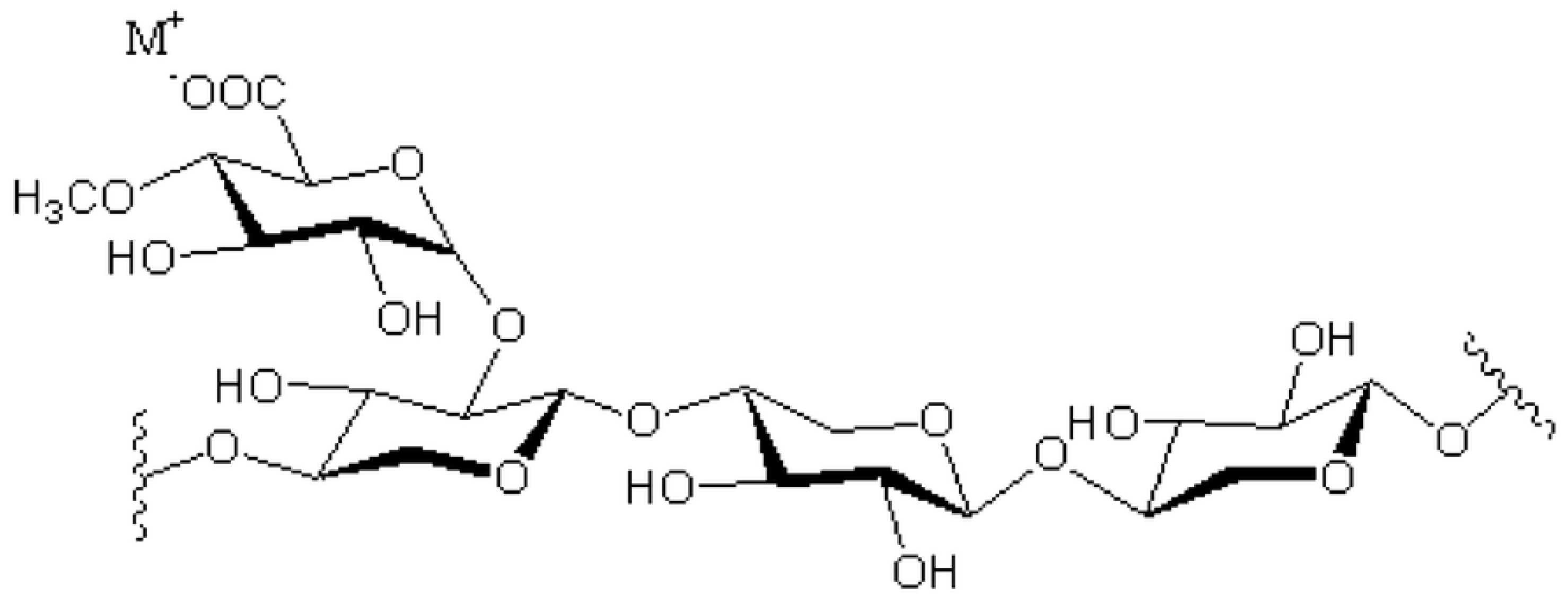

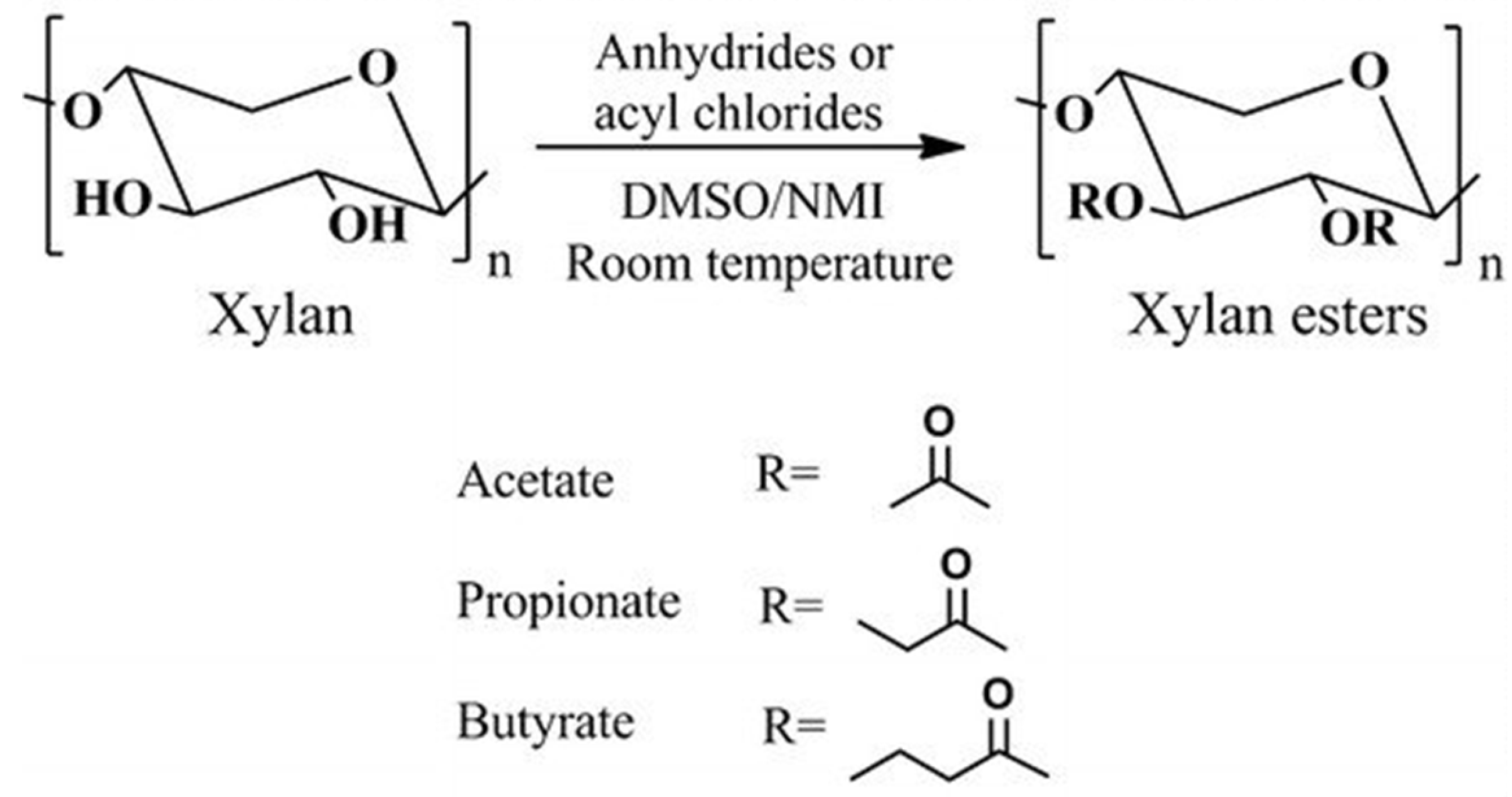
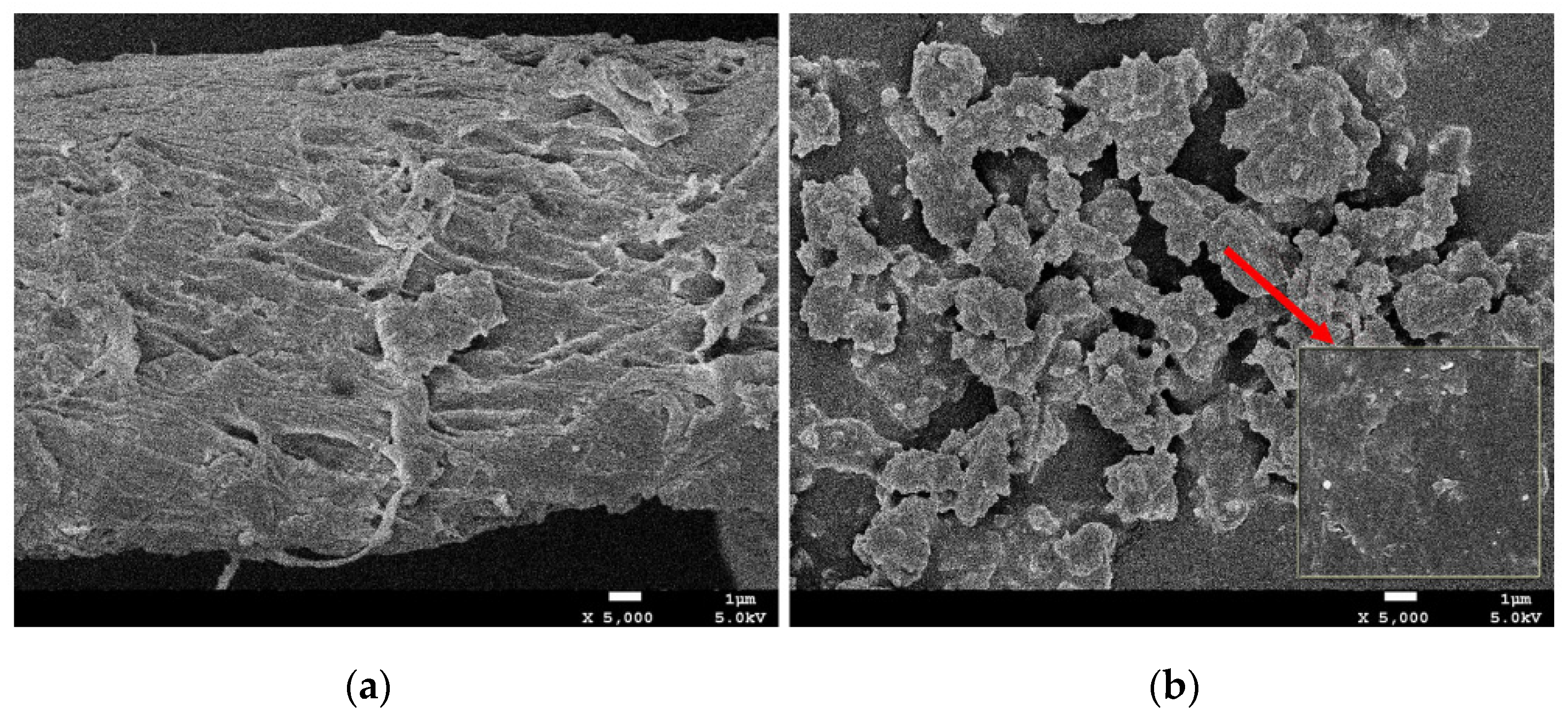
| Property | PLA | Cellulose Acetate | Acetylated Xylan |
|---|---|---|---|
| Strength, MPa | 48 | 48 | 61 |
| Young’s Modulus, GPa | 2.7 | 1.9 | 2.1 |
| Elongation to break, % | 5–10 | 2.6 | 22.3 |
| Water contact angle, ° | 75 | 50–55 | 66 |
| Moisture uptake in water or at 97% RH, % | ≤1%(moisture) | 5 (water) | 6 (moisture) |
| Transparency | high | high | high |
| Property | Native Xylan | Acetylated Xylan |
|---|---|---|
| Thermal stability | Low | Improved |
| Thermoplasticity | None | Heat processable |
| Solubility | Water | Apolar or aprotic solvents |
| Film forming ability | Excellent | Excellent |
| Mechanical strength | Good | Good |
| Stiffness | Good | Improved |
| Flexibility | Good | Excellent |
| Contact angle to water | Low; eventual dissolution | Higher |
| Moisture sorption | High | Low |
| Water permeability | n.a. | In a range with other bioplastics |
| Oxygen barrier properties | Good/excellent | Low |
| Imidazolium Salts | ||
| 1-Ethyl-3-methylimidazolium salts | ||
| Ethyl- Methylimidazolium Chloride [EmimCl] | Ethyl-Methylimidazolium Formate [EmimFmO] | Ethyl-Methylimidazolium Acetate [EmimAc] |
 |  |  |
| 1-Butyl-3-methylimidazolium salts | ||
| Butyl-methylimidazolium Formate [BmimFmO] | Butyl-methylimidazolium Chloride [BmimCl] | Butyl-methylimidazolium dicyanoamide [BmimDca] |
 |  |  |
| 1-Allyl-3-methylimidazolium salt | 1-Hexyl-3-methylimidazolium salts | |
| Allyl-methylimidazolium chloride [AmimCl] | Hexyl-methylimidazolium chloride [HmimCl] | |
 |  | |
| Imidazolium salts with substitution at position 2 | ||
| 1-Butyl-2,3-dimethylimidazolium cloride [BdmimCl] | 1-Allyl-2,3-dimethylimidazolium bromide [AdmimBr] | |
 |  | |
| Pyridinium salts | Ammonium salts | |
| 1-Butyl-3-methylpyridinium–chloride [BMPyCl] | N-Ethylpyridinium-chloride [EpyCl] | Benzyldimethyl ammonium chloride [BDTACl] |
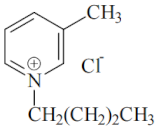 | 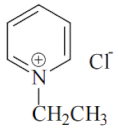 | 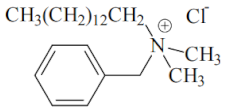 |
Disclaimer/Publisher’s Note: The statements, opinions and data contained in all publications are solely those of the individual author(s) and contributor(s) and not of MDPI and/or the editor(s). MDPI and/or the editor(s) disclaim responsibility for any injury to people or property resulting from any ideas, methods, instructions or products referred to in the content. |
© 2023 by the authors. Licensee MDPI, Basel, Switzerland. This article is an open access article distributed under the terms and conditions of the Creative Commons Attribution (CC BY) license (https://creativecommons.org/licenses/by/4.0/).
Share and Cite
Nechita, P.; Roman, M.; Năstac, S.M. Green Approaches on Modification of Xylan Hemicellulose to Enhance the Functional Properties for Food Packaging Materials—A Review. Polymers 2023, 15, 2088. https://doi.org/10.3390/polym15092088
Nechita P, Roman M, Năstac SM. Green Approaches on Modification of Xylan Hemicellulose to Enhance the Functional Properties for Food Packaging Materials—A Review. Polymers. 2023; 15(9):2088. https://doi.org/10.3390/polym15092088
Chicago/Turabian StyleNechita, Petronela, Mirela Roman (Iana Roman), and Silviu Marian Năstac. 2023. "Green Approaches on Modification of Xylan Hemicellulose to Enhance the Functional Properties for Food Packaging Materials—A Review" Polymers 15, no. 9: 2088. https://doi.org/10.3390/polym15092088
APA StyleNechita, P., Roman, M., & Năstac, S. M. (2023). Green Approaches on Modification of Xylan Hemicellulose to Enhance the Functional Properties for Food Packaging Materials—A Review. Polymers, 15(9), 2088. https://doi.org/10.3390/polym15092088








